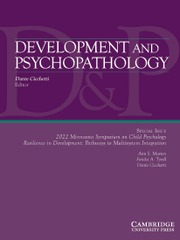No CrossRef data available.
Article contents
Pathways from child maltreatment to internalizing problems: Perceptions of control asmediators and moderators
Published online by Cambridge University Press: 14 January 2002
Abstract
Using a prospective longitudinal design, we examined internalizing problems and perceptionsof control in a community sample of 785 children, 59 of whom had been maltreated.Children's internalizing problems and perceptions of control were measured via self-reportat annual assessments in third grade through seventh grade (modal ages 9–13 years).Children's experiences of multiple types of maltreatment were rated based on social servicerecords, using a standard coding system. Results of longitudinal analyses examining the roles ofspecific types of maltreatment (neglect, harsh parenting, and sexual abuse) revealed that neglectand sexual abuse were each associated with more internalizing problems, especially amongchildren who experienced both these maltreatment types. Neglected children reported higherlevels of perceived external control than other children did. Sexual abuse was associated withhigher levels of perceived external control, but only among children who had also been neglected.Results of mediation analyses showed that higher levels of perceived external control accountedsubstantially for associations between specific maltreatment types and children'sinternalizing problems. Results of moderator analyses revealed that, among maltreated children,greater perceived internal control predicted fewer internalizing problems, suggesting thatperceived internal control functioned as a protective factor. Children maltreated early in life wereless likely to have this protective characteristic. Results are discussed in terms of their implicationsfor understanding the developmental consequences of specific and co-occurring types ofmaltreatment.
Information
- Type
- Research Article
- Information
- Copyright
- © 2001 Cambridge University Press

